It seems that the kings are just getting bigger every year. We are now regularly landing fish around the 1m mark with some considerably bigger fish occasionally getting in on the act.
Hooking one of these big fish is easy but actually landing one around the heavy structure where they are often found is another matter, and to some degree is linked more to technique than tackle upgrade.
Going up in line class creates a number of problems, including difficulties in delivering baits or lures and a decrease in interest from the fish due the obvious distraction of heavy traces. Heavy Gelspun lines are a poor defense around barnacle-encrusted structure despite allowing better presentations than mono of the same class. Furthermore, heavy line and drag settings are inherently detrimental to the technique that best suits landing big kings.
Working on the theory that the harder you pull the harder the kings pull, I’ve found it best to go fairly lightly until the fish is clear of the cover. Some fish charge straight into the cover regardless of what you do and I don’t think that there’s a thing you can do about it. But in general I’ve found that leading fish away from cover gently is a lot more productive than going hammer and tong.
In rough country a good Skipper is an asset. Quite often, for reasons unknown, big kings will run straight away from cover. This is great if it happens but you have to know how to handle it. The natural instinct is to chase the fish out but this can prompt the fish to swim against the direction of the pull and back towards the cover. Instead, stay close to the cover and let the fish tire for a while before chasing him. I’ve never had a king swim back towards the boat like tuna do, so keeping the boat near the cover will ensure that the fish will not swim back to it.
Once you are confident that the fish is either tired or too far from the cover to get back then move the boat quickly towards him. From here on keep the boat directly above the fish. The greater the angle of the line is from the boat the more chance the fish has of clipping it across the top of bottom structure.
Being directly above the fish means that to make any ground downwards towards the bottom structure means that he will have to take drag, expending more energy. Low line angles created by the fish being away from the boat mean that the fish needs only to swim sideways to make ground towards cover, without having to take drag.
In the case where you have lead the fish gently away from cover, wait until you feel you are a safe distance from the cover and then go hard. But ensure that before you get stuck into it, you place the boat between the fish and the cover in an effort to encourage the fish to swim away from the boat and hence away from the cover.
All this is much easier if you are drifting but it can be achieved at anchor providing your crew acts quickly. Once the fish is close to the boat back the drag off a touch to compensate for the reduced stretch of a shorter line.
Presenting your bait in such a way that draws the fish away from the cover has obvious benefits. This is done by casting your bait so it lands very close to the structure and letting it sink, on a tight line, back towards the boat. This encourages the king to chase the bait out of the structure.
Egg beaters are my first choice and you can’t go past the big 950 Penn Spinfisher. They are indestructible and with new refinements like balanced rotor, infinite anti-reverse (long overdue) and longer spool oscillation (designed for braid) they will fish alongside the likes of Stella and Saltiga.
Eggbeaters work for straight down bait fishing, casting unweighted live squid at structure or heavy lure fishing the likes of 9” Slug-go and heavy metal casting and jigging. With modern braids, capacity is no issue and they have a drag range to get the best out of any line class from 10-20kg.
If you are targeting really big kings then the Penn 330 leaver drag might be a better option but you do loose versatility once you go to an overhead.
A big modern sturdy eggbeater is up to the challenge of most harbour kings.
Go glass. Anything but the very best of graphite rods won’t stand up to the rough and tumble of kings.
Penn make a matching rod for the 950 that is ideal. A 6’6” will give you a bit extra push for casting and enough reach to keep the line off the boat/motor when your king inevitably takes a lunge under.
Braid is the way to go overall despite the tangles and the occasional pulled hook on short lines. Spool up with 50lb for kings.
My theory is you don’t have to use it all but it offers greater abrasion resistance and you can crank it up if you need to. As I said earlier, capacity is not an issue any more. I use Suffix Performance braid in this line class.
Fluorocarbon is the obvious choice, given that it is inevitably going to get dragged over rough surfaces. I would use 60-80lb for bigger kings (depending on terrain) and 40lb for smaller fish.
The compromise with trace weights is in hook-ups and experience has shown that you will defiantly get more hook-ups when using lighter trace.
Best spots to look for kings in the harbour are: The eastern cardinal mark off Dobroyd; the green marker off Middle Head; the Wedding Cakes; the Spit; Seaforth Bluff; Pickering Point; Old Yella off Neilson Park; and, the sticks off Rose Bay.
Reads: 1840
The water temperature was around 22.4°C in around 7m depth. These bass were very active and feeding along the bank that runs to about 12m. You can see on bottom of sounder the weed starting to grow.
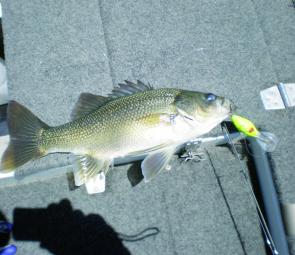
This bass was caught at St Clair on a Mann's 15+ cast along the bank. The fish was one of about 15 caught in the area and all were full of smelt.
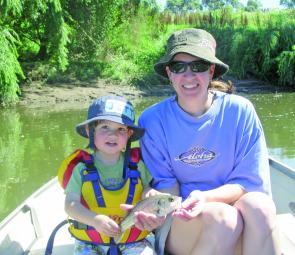
Beth and son Jett from Morpeth, near Maitland, with Jett’s first bass. The little specimen was caught on a locally made Marz botfly in black.

Travis caught his PB bass of 45cm whilst trolling a Marz black botfly.
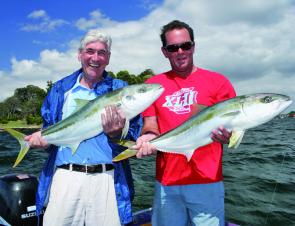
Hooking up kings is the easy part, but trying to land one around heavy-structure requires a bit more skill.
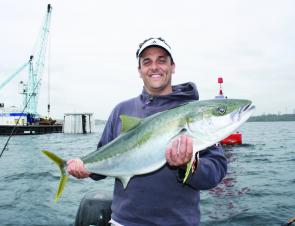
A big modern sturdy eggbeater reel is up to the challenge of most harbour kings.
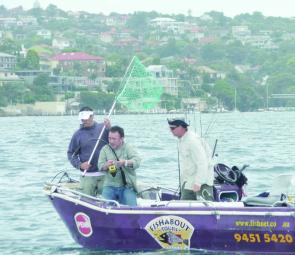
In rough country a good Skipper is an asset as quite often, for reasons unknown, big kings will run straight away from cover.




